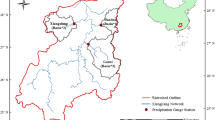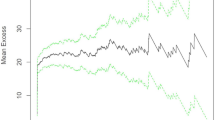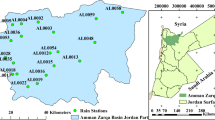Abstract
Various approaches have been widely proposed for simulation of the occurrence and the amount of daily rainfall. In this study, a piecewise distribution approach has been developed to improve extreme event amount simulation. The gamma-generalized Pareto (GGP) approach employs a combination of the generalized Pareto (GP) and the gamma density estimation method to model the daily rainfall distribution. Furthermore, three stochastic rainfall time series generations have been developed and compared to simulate the daily rainfall occurrence based on the first-order Markov chain (MC1), the second-order Markov chain (MC2) and the third-order Markov chain (MC3) approaches. 30 years daily datasets from 5 synoptic stations have been used in the semi-arid extra cold in Iran. The performance of different approaches has been compared using Akaike information climate criterion (AIC) and root mean square error (RMSE). Results show that MC1 performs relatively better than MC2 and MC3 for daily rainfall occurrence modeling. Results also show that the GGP probability density performs better to reproduce extreme daily rainfall compared with gamma, GP and exponential distributions.





Similar content being viewed by others
References
Akaike H (1974) A new look at the statistical model identification. IEEE T Automat Contr 19:716–723
Ben-Gai T, Bitan A, Manes A, Alpert P, Rubin S (1998) Spatial and temporal changes in rainfall frequency distribution patterns in Israel. Theor Appl Climatol 61:177–190
Byung-Jin S, Hyun-Han K, Dongkyun K, Seung OL (2015) Modeling of daily rainfall sequence and extremes based on a semi-parametric Pareto tail approach at multiple locations. J Hydrol 529:1442–1450
Daniel S (1985) Statistical methods in the atmospheric sciences. Dep of soil, Crop and Atmospheric Sciences, ITHACA, Cornell Univ, New York
Dastidar AG, Gosh D, Dasgupta S, De UK (2010) Higher order Markov chain models for monsoon rainfall over West Bengal, India. IJRSP 39:39–44
Furrer EM, Katz RW (2008) Improving the simulation of extreme precipitation events by stochastic weather generators. Water Resour Res 44:1–13
Hanum H, Wigena AH, Djuraidah A, Mangku IW (2015) Modeling extreme rainfall with gamma-Pareto distribution. Appl Math Sci 121:6029–6039
Hyndman RJ, Koehler AB (2006) Another look at measures of forecast accuracy. Int J Forecasting 22:679–688
Katz RW (1981) On some criteria for estimating the order of a Markov chain. Technometrics 23:243–249
Khalili A (1997) Integrated water plan of Iran. Meteorol Stud, Ministry of power, Iran
Li Z, Li Z, Zhao W, Wang Y (2015) Probability modeling of precipitation extremes over two river basins in northwest of China. Adv Meteorol 2015:1–13
Liu C, Ikeda K, Thompson G, Rasmussen R, Dudhia J (2011) High-resolution simulations of wintertime precipitation in the Colorado headwaters region: sensitivity to physics parameterizations. Monthly Weather Rev 139:3533–3553
Mandal KG, Padhi J, Kumar A, Ghosh S, Panda DK, Mohanty RK, Raychaudhuri M (2015) Analyses of rainfall using probability distribution and Markov chain models for crop planning in Daspalla region in Odisha, India. Theor Appl Climatol 121:517–528
Mhanna M, Bauwens W (2011) A stochastic space-time model for the generation of daily rainfall in the Gaza strip. Int J Climatol:1–15
Mhanna M, Bauwens W (2012) Stochastic single-site generation of daily and monthly rainfall in the Middle East. Meteorol Appl 19:111–117
Moon SE, Ryoo SB, Kwon JG (1994) A Markov chain model for daily precipitation occurrence in South Korea. Int J Climatol 14:1009–1016
Moradi HR, Rajabi M, Faragzade M (2011) Investigation of meteorological drought characteristics in Fars province, Iran. CATENA 84:35–46
Mouelhi S, Nemri S, Jebari S, Slimani M (2016) Using the Markov chain for the generation of monthly rainfall series in a semi-arid zone. Open J Mod Hydrol 6:51–65
Nalbantis I, Tsakiris G (2009) Assessment of hydrological drought revisited. Water Resour Manag 23:881–897
Ng JL, Aziz SA, Huang YF, Wayayok A, Rowshon MK (2017) Generation of a stochastic precipitation model for the tropical climate. Theor Appl Climatol 133:489–509
Papalaskaris T, Panagiotidis T, Papadopoulos S, Pantrakis A (2016) Stochastic generation of daily rainfall, in Kavala city station, North- Eastern Greece. Procedia Eng 162:162–171
Paulo AA, Pereira LS (2007) Prediction of SPI drought class transitions using Markov chains. Water Resour Manag 21:1813–1827
Qian B, Gameda S, Hayhoe H (2008) Performance of stochastic weather generators LARS-WG and AAFC-WG for reproducing daily extremes of diverse Canadian climates. Clim Res 37:17–33
Sanusi W, Jemain AA, Zin WZW, Zahari M (2015) The drought characteristics using the first-order homogeneous Markov chain of monthly rainfall data in peninsular Malaysia. Water Resour Manag 29:1523–1539
Schoof JT, Pryor SC (2008) On the proper order of Markov chain model for daily precipitation occurrence in the contiguous United States. J Appl Meteorol Clim 47:2477–2486
Schwarz G (1978) Estimating the dimension of a model. Ann Stat 6:461–464
Semenov MA (2008) Simulation of extreme weather events by a stochastic weather generator. Clim Res 35:203–212
Senthilvelan A, Ganesh A, Banukumar K (2012) Markov chain model for probability of weekly rainfall in Orathanadu taluk, Thanjavur District, Tamil Nadu. Int J Geom Geosci 3:191–203
Shin JY, Lee T, Ouarda TBMJ (2015) Heterogeneous nixture distributions for modeling multisource extreme rainfalls. J Hydrometeorol 16:2639–2657
Soleh AM, Wigena AH, Djuraidah A, Saefuddin A )2017( Gamma distribution linear modeling with statistical downscaling to predict extreme monthly rainfall in Indramayu. 12th International Conference on Mathematics, Statistics, and Their Applications (ICMSA), Banda Aceh, Indonesia
Sonnadara DUJ, Jayewardene DR (2015) A Markov chain probability model to describe wet and dry patterns of weather at Colombo. Theor Appl Climatol 119:333–340
Srikanthan R, Pegram GGS (2009) A nested multisite daily rainfall stochastic generation model. J Hydrol 371:142–153
Srinivasareddy GV, Bhaskar RS, Purohit RC, Chittora AK (2008) Markov chain model probability of dry, wet weeks and statistical analysis of weekly rainfall for agricultural planning at Bangalore. Karnataka J Agric Sci 21:12–16
Syafrina AH, Norzaida A, Noor Shazwani O (2018) Stochastic modeling of rainfall series in Kelantan using an advanced -weather generator. ETASR 8:2537–2541
Tabari H, Zamani R, Rahmati H, Willems P (2015) Markov chains of different orders for streamflow drought analysis. Water Resour Manag 29:3441–3457
Tong H (1975) Determination of the order of a Markov chain by Akaike’s information criterion. J Appl Probab 12:488–497
van Montfort MAJ, Witter JV (1986) The generalized Pareto distribution applied to rainfall depths. Hydrolog Sci J 31:151–162
Vrac M, Naveau P (2007) Stochastic downscaling of precipitation: from dry events to heavy rainfalls. Water Resour Res 43:1–13
Wilks DS (1998) Multisite generalization of a daily stochastic precipitation generation model. J Hydrol 210:178–191
Wilks DS (1999) Interannual variability and extreme-value characteristics of several stochastic daily precipitation models. Agric For Meteorol 93:153–169
Woolhiser DA, Roldan J (1982) Stochastic daily precipitation models: 2. A comparison of distributions of amounts. Water Resour Res 18:1461–1468
Author information
Authors and Affiliations
Corresponding author
Ethics declarations
Conflict of Interest
The authors express that there is no conflict of interests regarding the publication of this paper.
Rights and permissions
About this article
Cite this article
Shahraki, N., Marofi, S. & Ghazanfari, S. Modeling of Daily Rainfall Extremes, Using a Semi-Parametric Pareto Tail Approach. Water Resour Manage 33, 493–508 (2019). https://doi.org/10.1007/s11269-018-2112-4
Received:
Accepted:
Published:
Issue Date:
DOI: https://doi.org/10.1007/s11269-018-2112-4




